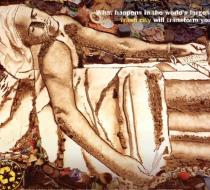From a Universe of Trash 2 Favorite
From a Universe of Trash, Recycling Art and Hope
By STEPHEN HOLDEN
“We are not pickers of garbage; we are pickers of recyclable materials,” Tião, an impoverished Brazilian catadore, or trash picker, declares to a talk-show host in Lucy Walker’s inspiring documentary “Waste Land.”
Tião, like the other catadores profiled in the film, is far from an emaciated beggar living out a miserable existence on the way to an early death. But he is humble and has few expectations of earthly glory. Although a social outcast, he organized an association of pickers who live and work in Jardim Gramacho, one of the world’s largest garbage dumps, and likes to think of himself as an environmentalist.
The film — co-directed by João Jardim and Karen Harley, and photographed by Dudu Miranda — observes this giant landfill from every perspective. Viewed from a distance, the pickers resemble insects crawling and slipping over the mountains of trash while scavenging birds circle overhead. What appears from afar to be chaos, however, is really a little universe unto itself. Most of the workers, who earn $20 to $25 a day combing through the refuse, live at Jardim Gramacho, which receives 70 percent of Rio de Janeiro’s trash.
Sorted into categories, the garbage is sold to a network of wholesalers and middlemen; recycled metal, for instance, eventually becomes buckets and car bumpers. Tião, whose organization has established a recycling center and a medical clinic as well as day care and skills-training centers for the catadores, boasts about the amount of garbage that is recycled. Zumbi, a board member of the association and its resident intellectual, has turned his shack into a community lending library of discarded books.
Tião is the most prominently featured of several pickers profiled by the film. Their lives are changed forever when they are chosen to collaborate with the artist Vik Muniz, a São Paulo native who is now based in Brooklyn and is well known for his re-creations of famous artworks using unusual materials. Those pieces include two Mona Lisas — one made of peanut butter, the other of jelly — and a “Last Supper” made of chocolate syrup. For his Sugar Children series, he took snapshots of children on a plantation in St. Kitts and copied the images by layering sugar on black paper and photographing the result.
The film observes the creation of his recent monumental series, Pictures of Garbage, for which Mr. Muniz, who grew up poor, returned to Brazil. For the piece “Marat (Sebastião),” a rendition of the Jacques-Louis David painting “The Death of Marat,” Tião is photographed in a discarded bathtub found in the landfill, striking the same pose as Jean-Paul Marat in the 1793 painting. In his nearby studio, Mr. Muniz blows up the picture and projects it on the floor as a magnified outline. Using a laser pointer, he directs from a scaffold as the pickers fill in the images with refuse from the landfill. A photograph of the finished assemblage, taken from the scaffold, is the final work of art.
“Waste Land” is more interested in the subjects of Mr. Muniz’s pieces than in the artistic process, which is barely described. They include Irma, who stirs up stews from the freshest ingredients she can find in the dump, and Suelem, an 18-year-old mother who takes pride in her work because she is not selling her body or dealing drugs.
Mr. Muniz, who seems manically happy throughout the film, expresses his amazement at how “the educated elite really believe they’re better than other people.” He has a mystical faith in the artistic power of transformation, as one thing becomes another and garbage is turned into art. He fervently believes that he is changing his subjects’ lives for the better by “showing them another place,” even if they never make it out of Jardim Gramacho.
When he takes Tião to an auction in London, where “Marat (Sebastião)” sells for $50,000, the young man weeps uncontrollably. Other subjects, confronting images of themselves at an exhibition in Rio, are overwhelmed. It is the first confirmation from the world outside the dump that their lives matter.
WASTE LAND
Directed by Lucy Walker; co-directed by João Jardim and Karen Harley; director of photography, Dudu Miranda; edited by Pedro Kos; music by Moby; produced by Angus Aynsley and Hank Levine; released by Arthouse Films. At the Angelika Film Center, Mercer and Houston Streets, Greenwich Village. In English and Portuguese, with English subtitles. Running time: 1 hour 38 minutes. This film is not rated.







